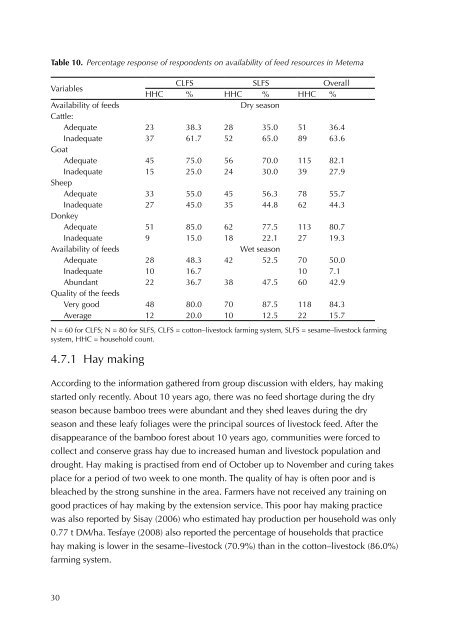Rangeland condition and feed resources in Metema District, North ...
Rangeland condition and feed resources in Metema District, North ...
Rangeland condition and feed resources in Metema District, North ...
You also want an ePaper? Increase the reach of your titles
YUMPU automatically turns print PDFs into web optimized ePapers that Google loves.
Table 10. Percentage response of respondents on availability of <strong>feed</strong> <strong>resources</strong> <strong>in</strong> <strong>Metema</strong><br />
Variables<br />
CLFS SLFS Overall<br />
HHC % HHC % HHC %<br />
Availability of <strong>feed</strong>s<br />
Dry season<br />
Cattle:<br />
Adequate 23 38.3 28 35.0 51 36.4<br />
Inadequate 37 61.7 52 65.0 89 63.6<br />
Goat<br />
Adequate 45 75.0 56 70.0 115 82.1<br />
Inadequate 15 25.0 24 30.0 39 27.9<br />
Sheep<br />
Adequate 33 55.0 45 56.3 78 55.7<br />
Inadequate 27 45.0 35 44.8 62 44.3<br />
Donkey<br />
Adequate 51 85.0 62 77.5 113 80.7<br />
Inadequate 9 15.0 18 22.1 27 19.3<br />
Availability of <strong>feed</strong>s<br />
Wet season<br />
Adequate 28 48.3 42 52.5 70 50.0<br />
Inadequate 10 16.7 10 7.1<br />
Abundant 22 36.7 38 47.5 60 42.9<br />
Quality of the <strong>feed</strong>s<br />
Very good 48 80.0 70 87.5 118 84.3<br />
Average 12 20.0 10 12.5 22 15.7<br />
N = 60 for CLFS; N = 80 for SLFS, CLFS = cotton–livestock farm<strong>in</strong>g system, SLFS = sesame–livestock farm<strong>in</strong>g<br />
system, HHC = household count.<br />
4.7.1 Hay mak<strong>in</strong>g<br />
Accord<strong>in</strong>g to the <strong>in</strong>formation gathered from group discussion with elders, hay mak<strong>in</strong>g<br />
started only recently. About 10 years ago, there was no <strong>feed</strong> shortage dur<strong>in</strong>g the dry<br />
season because bamboo trees were abundant <strong>and</strong> they shed leaves dur<strong>in</strong>g the dry<br />
season <strong>and</strong> these leafy foliages were the pr<strong>in</strong>cipal sources of livestock <strong>feed</strong>. After the<br />
disappearance of the bamboo forest about 10 years ago, communities were forced to<br />
collect <strong>and</strong> conserve grass hay due to <strong>in</strong>creased human <strong>and</strong> livestock population <strong>and</strong><br />
drought. Hay mak<strong>in</strong>g is practised from end of October up to November <strong>and</strong> cur<strong>in</strong>g takes<br />
place for a period of two week to one month. The quality of hay is often poor <strong>and</strong> is<br />
bleached by the strong sunsh<strong>in</strong>e <strong>in</strong> the area. Farmers have not received any tra<strong>in</strong><strong>in</strong>g on<br />
good practices of hay mak<strong>in</strong>g by the extension service. This poor hay mak<strong>in</strong>g practice<br />
was also reported by Sisay (2006) who estimated hay production per household was only<br />
0.77 t DM/ha. Tesfaye (2008) also reported the percentage of households that practice<br />
hay mak<strong>in</strong>g is lower <strong>in</strong> the sesame–livestock (70.9%) than <strong>in</strong> the cotton–livestock (86.0%)<br />
farm<strong>in</strong>g system.<br />
30

















